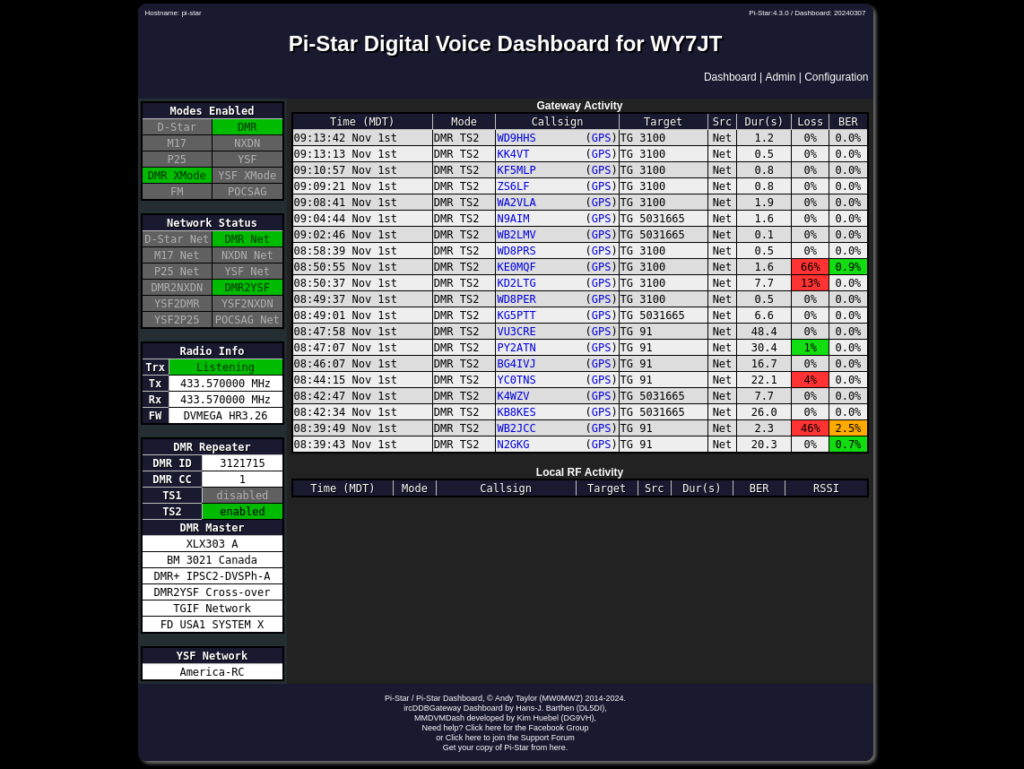I switched to Chip’s WPSD back when he came out with a Bullseye version ahead of Andy, and the old Pi-Star was looking like it might be on life support. Originally Chip’s version had a bug with simplex hotspots where the Brandmeister Manager wasn’t sending the proper time slot, for which I reached out and Chip fixed it. And Chip’s dark mode layout was nice and could be tweaked to be darker. But he and some other contributors have been adding so many features to the dashboard which was always a bit slower, to the point where it’s now become quite bloated. I would actually reboot mine every morning because I noticed the dashboard would be a little more responsive. And you have to click around to too many screens to change talkgroups and links. And lately there have been a few too many bugs, and I didn’t care for how he was doing updates with unnattended-upgrades or adding systemd services and hiding scripts.
So I grabbed Andy’s Pi-Star 4.3 beta and put it on my digital hotspots. Luckily I had old backups so getting them up and running was pretty easy. But right away I was struck by just how much faster the interface is on my machines, a Raspberry Pi 3A+ and two Pi Zero 2’s. I have a Pi 4 and Pi 5 running Bitcoin nodes with extra features as they’re so capable, and I didn’t want to have to dedicate that kind of processing power to a hotspot just to run a bloated dashboard. Consequently, just looking at the load while they’re running and it’s a stark difference to Chips WPSD, and that’s with two webpages active. This also equates to running cooler as the processors don’t have to speed up all the time.

Also, because I like to keep an eye on my computers, the above Screen terminals have Btop running along with tail displays of the log files for DMRGateway and MMDVMHost. Which brings me to the latest bug with Chip’s WPSD, the MMDVMHost would stop logging.
As I didn’t want a bright display, a little tweaking with the color values and I got Pi-Star to the following darker mode that will work for me. And I’m still blown away with how much simpler Andy’s version is, and how that translates into so much more snappiness.

I still need to tweak mine to add VE3RD’s DMRGateway as I like the ability to switch between his and the stock version, or my own compiled version. Phil’s gateway has network isolation and you can switch networks with TG 9001 to switch to network 1, TG 9002 to switch to network 2… And Phil’s gateway allows you to use native talk groups on each network without needing talk group translation. And the original DMRGateway is nice if you want to monitor multiple networks at the same time including YSF.
All that to say, I’m enjoying being back on the original Pi-Star which just works so much better. And a positive for Andy, he’s very conservative in what version of things he uses and making sure they’re adequately vetted. So if you’re having issues with WPSD, maybe it’s time to go back to Andy’s original Pi-Star. And Andy has the Bookworm Beta up for download, and there were a lot of updates after install so the original Pi-Star is alive and well.